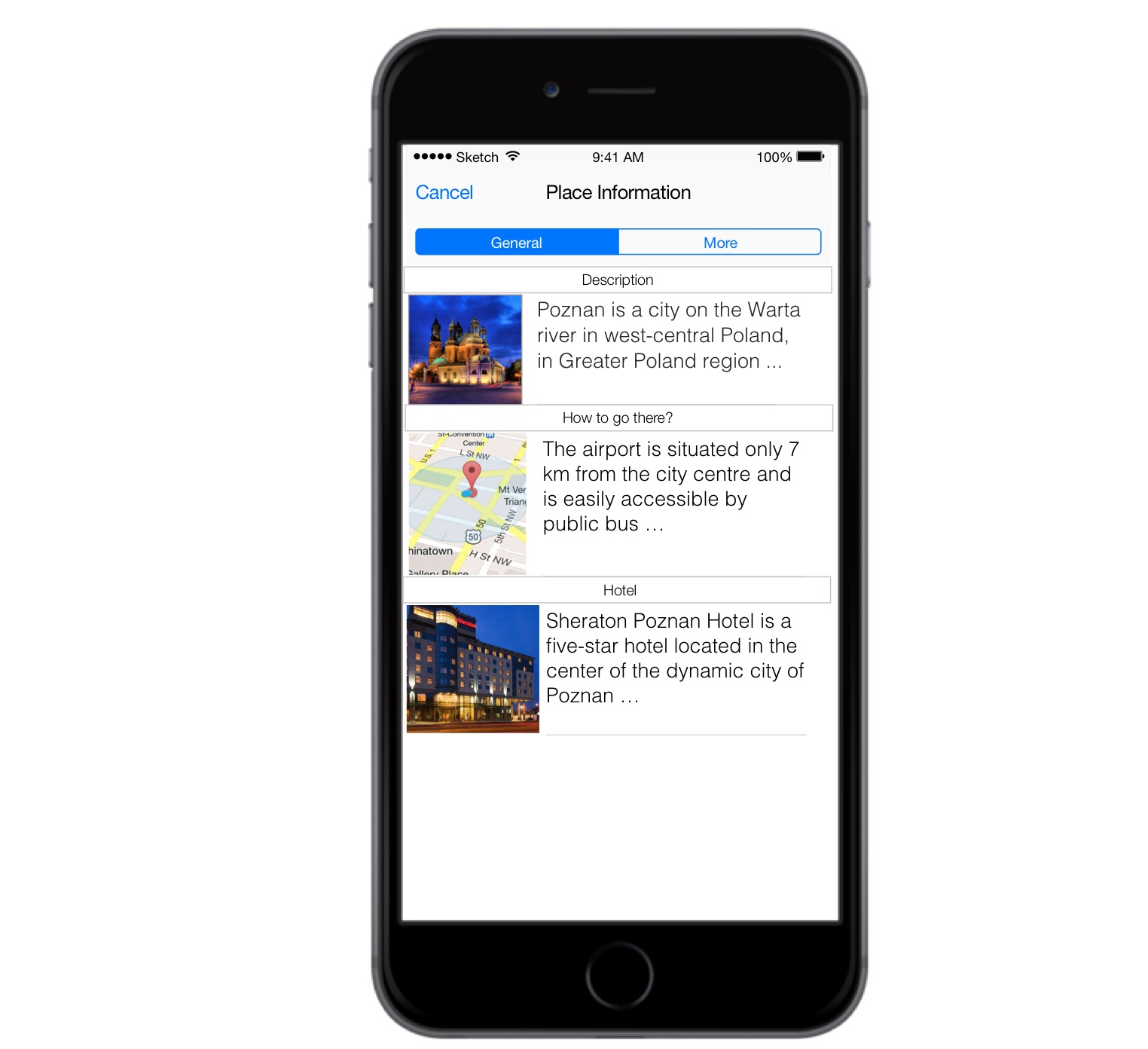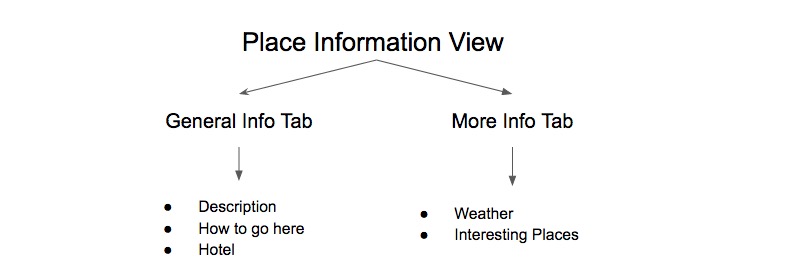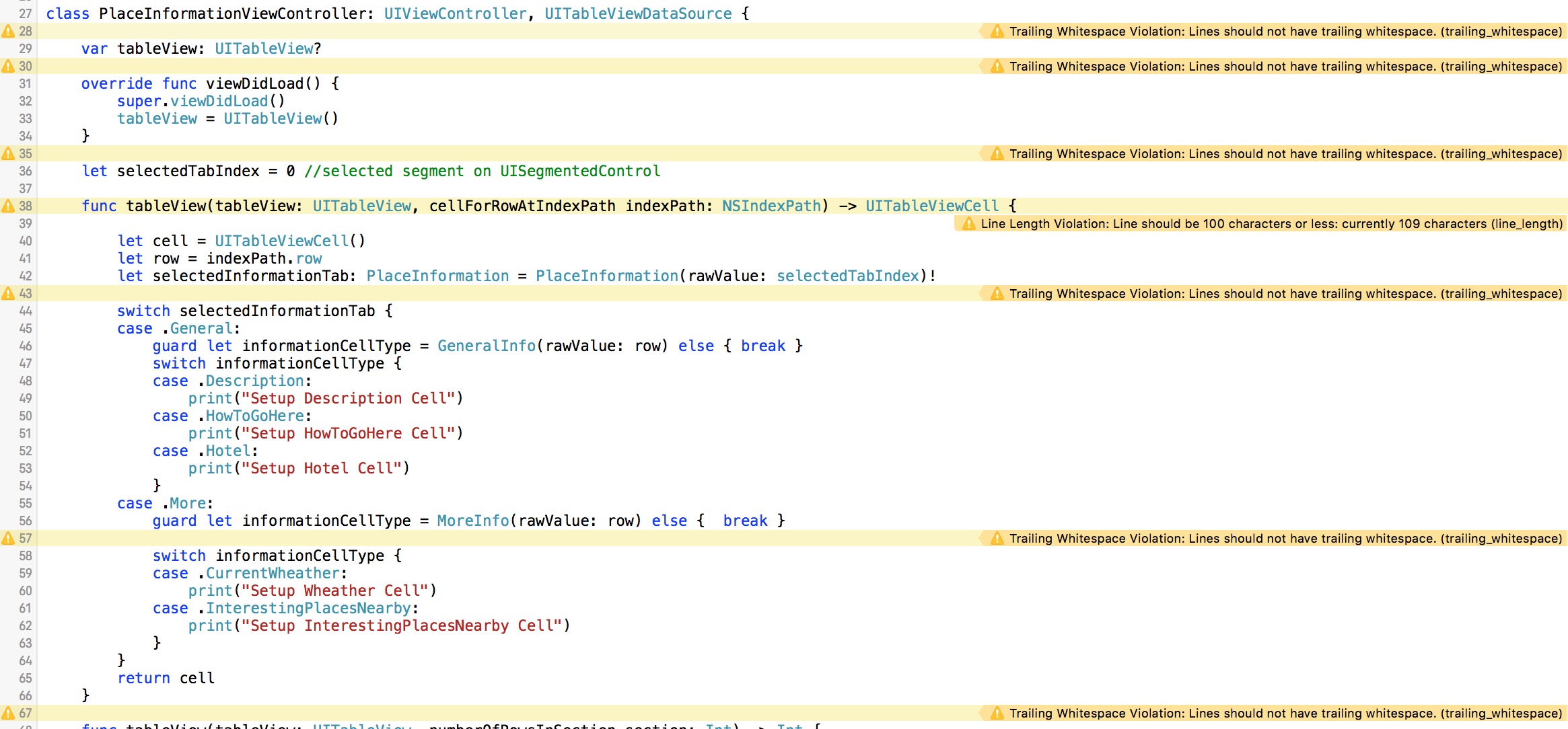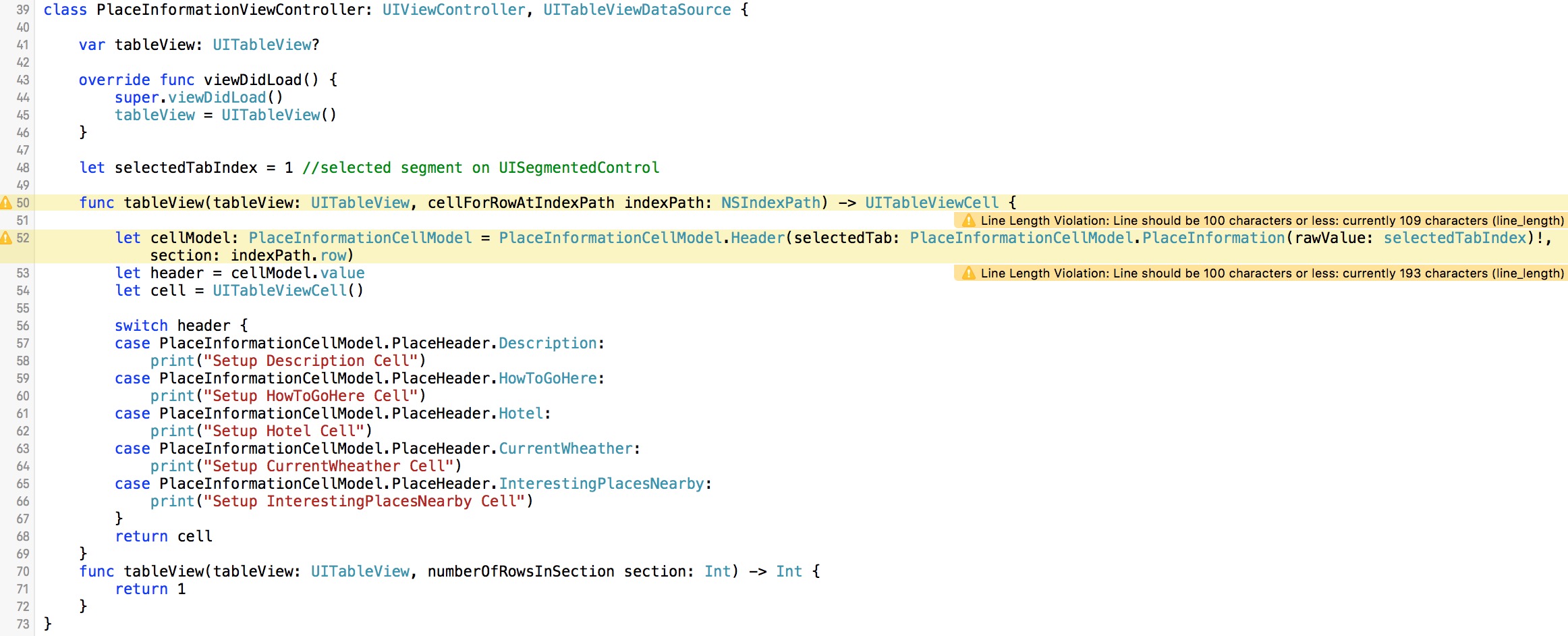#15 Nested enums or rather never ending posts about enums:)
Today I would like to discuss how to present UITableViewCell contents by using enums. A simple switch statement can help us with displaying data on our tableView. What scenario would I like to focus on?

To be more precise, I have created a simple schema of this screen:

By the way, have you had a chance to use Sketch for prototyping? Quite a nice tool!!!
The question is: what is the best proposal of enum configurations and functions, which can help us with displaying data when using tableView:cellForRowAtIndexPath: method for an example above?
My first proposal was:
enum PlaceInformation: Int { // Used on UISegmentControl
case General
case More
}
enum GeneralInfo: Int {//Cells for General Info Segment (Tab)
case Description
case HowToGoHere
case Hotel
}
enum MoreInfo: Int {//Cells for More Info Segment (Tab)
case CurrentWheather
case InterestingPlacesNearby
}
class PlaceInformationViewController: UIViewController, UITableViewDataSource {
var tableView: UITableView?
override func viewDidLoad() {
super.viewDidLoad()
tableView = UITableView()
...
}
let selectedTabIndex = 0 //selected segment on UISegmentedControl
func tableView(tableView: UITableView, cellForRowAtIndexPath indexPath: NSIndexPath) -> UITableViewCell {
let cell = UITableViewCell()
let row = indexPath.row
let selectedInformationTab: PlaceInformation = PlaceInformation(rawValue: selectedTabIndex)!
switch selectedInformationTab {
case .General:
guard let informationCellType = GeneralInfo(rawValue: row) else { break }
switch informationCellType {
case .Description:
print("Setup Description Cell")
case .HowToGoHere:
print("Setup HowToGoHere Cell")
case .Hotel:
print("Setup Hotel Cell")
}
case .More:
guard let informationCellType = MoreInfo(rawValue: row) else { break }
switch informationCellType {
case .CurrentWheather:
print("Setup Wheather Cell")
case .InterestingPlacesNearby:
print("Setup InterestingPlacesNearby Cell")
}
}
return cell
}
func tableView(tableView: UITableView, numberOfRowsInSection section: Int) -> Int {
return 1
}
}
Some statistics of the above code:
- Lines of code of tableView:cellForRowAtIndexPath: function: 28
- What did SwiftLint say?

My intuition prompted that it can be done better:). So I have started thinking of how to refactor the code.
First refactoring
So here we go with first refactoring. Below is my to do list to make this enum better:
- Remove white spaces according to SwiftLint
- Reduce cases in enum to one line
- Use nested enums
- Necessarily I wanted to check if enum associated values can improve code metrics. I don’t know why, but I hoped that it will improve my situation:)
enum PlaceInformationCellModel {
// returned cell depends on selectedTab and tableview section
case Header(selectedTab: PlaceInformation, section: Int)
enum PlaceInformation: Int { // Used on UISegmentControl
case General
case More
}
enum PlaceHeader {
case Description, HowToGoHere, Hotel, CurrentWheather, InterestingPlacesNearby
static let allGeneralHeaders = [Description, HowToGoHere, Hotel]
static let allMoreHeaders = [CurrentWheather, InterestingPlacesNearby]
}
var value: PlaceHeader {
switch self {
case .Header(let tab, let sectionIndex):
switch tab {
case .General:
return PlaceHeader.allGeneralHeaders[sectionIndex]
case .More:
return PlaceHeader.allMoreHeaders[sectionIndex]
}
}
}
}
class PlaceInformationViewController: UIViewController, UITableViewDataSource {
var tableView: UITableView?
override func viewDidLoad() {
super.viewDidLoad()
tableView = UITableView()
...
}
let selectedTabIndex = 1 //selected segment on UISegmentedControl
func tableView(tableView: UITableView, cellForRowAtIndexPath indexPath: NSIndexPath) -> UITableViewCell {
let cellModel: PlaceInformationCellModel = PlaceInformationCellModel.Header(selectedTab: PlaceInformationCellModel.PlaceInformation(rawValue: selectedTabIndex)!, section: indexPath.row)
let header = cellModel.value
let cell = UITableViewCell()
switch header {
case PlaceInformationCellModel.PlaceHeader.Description:
print("Setup Description Cell")
case PlaceInformationCellModel.PlaceHeader.HowToGoHere:
print("Setup HowToGoHere Cell")
case PlaceInformationCellModel.PlaceHeader.Hotel:
print("Setup Hotel Cell")
case PlaceInformationCellModel.PlaceHeader.CurrentWheather:
print("Setup CurrentWheather Cell")
case PlaceInformationCellModel.PlaceHeader.InterestingPlacesNearby:
print("Setup InterestingPlacesNearby Cell")
}
return cell
}
func tableView(tableView: UITableView, numberOfRowsInSection section: Int) -> Int {
return 1
}
}
Is it better? I hoped so, so I have asked my friends about feedback:
-
Lines of code of tableView:cellForRowAtIndexPath: function: 20
-
What did SwiftLint say?

- What did codebeat say?: 4.00 GPA
Second refactoring
I still had a feeling that the code was too complicated. I thought that getting rid of associated values would make it simpler.
enum PlaceInformation {
case General, More
enum PlaceHeader: Int {
case Description, HowToGoHere, Hotel, CurrentWheather, InterestingPlacesNearby
static let allGeneralHeaders = [Description, HowToGoHere, Hotel]
static let allMoreHeraders = [CurrentWheather, InterestingPlacesNearby]
}
var placeValues: [PlaceHeader] {
switch self {
case .General:
return PlaceHeader.allGeneralHeaders
case .More:
return PlaceHeader.allMoreHeraders
}
}
}
class PlaceInformationViewController: UIViewController, UITableViewDataSource {
var tableView: UITableView?
override func viewDidLoad() {
super.viewDidLoad()
tableView = UITableView()
}
let selectedInformationTab: PlaceInformation = .General
func tableView(tableView: UITableView, cellForRowAtIndexPath indexPath: NSIndexPath) -> UITableViewCell {
let header = selectedInformationTab.placeValues[indexPath.row]
let cell = UITableViewCell()
switch header {
case .Description:
print("Setup Description Cell")
case .HowToGoHere:
print("Setup HowToGoHere Cell")
case .Hotel:
print("Setup Hotel Cell")
case .CurrentWheather:
print("Setup CurrentWheather Cell")
case .InterestingPlacesNearby:
print("Setup InterestingPlacesNearby Cell")
}
return cell
}
func tableView(tableView: UITableView, numberOfRowsInSection section: Int) -> Int {
return 1
}
}
Feedback:
- Lines of code of tableView:cellForRowAtIndexPath: function: 18
- SwiftLint:

It seems that the easiest solution is the best:

Third refactoring
I would like to leave the next iteration of refactoring for you. What would you change to improve the solution?
